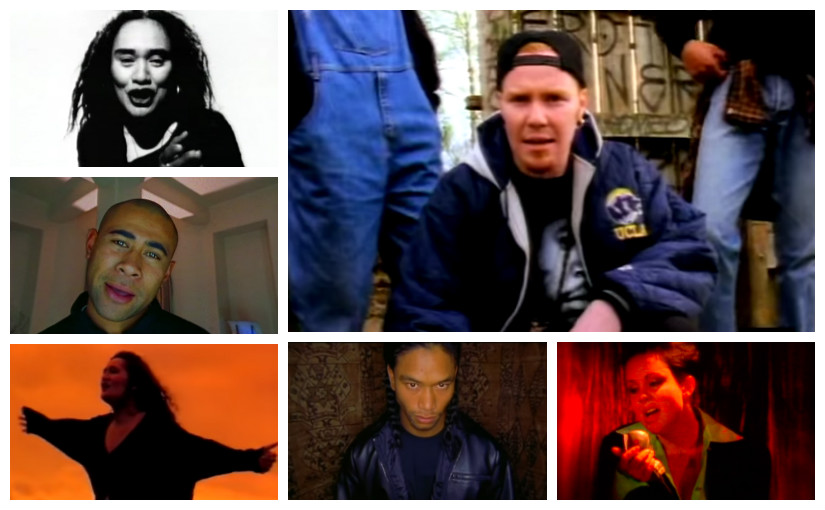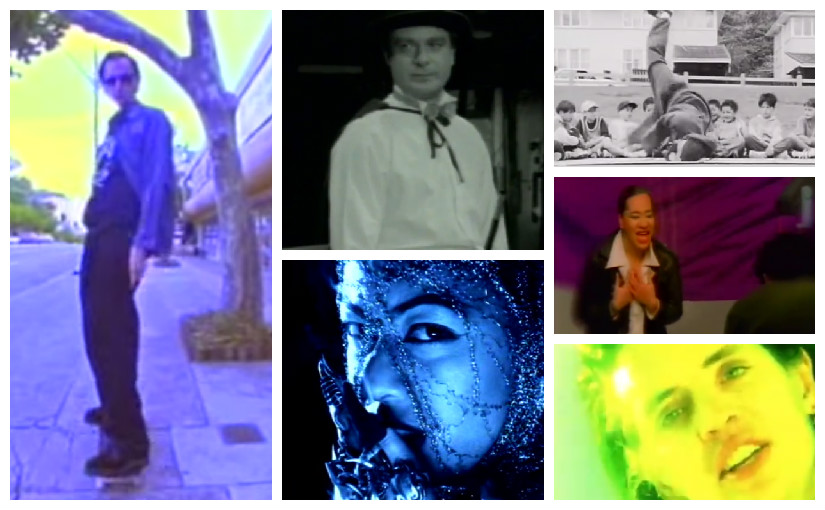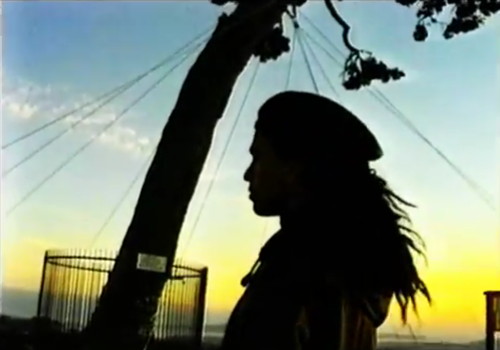Windswept beachiness, urban Balkan, Christchurch in the before time, racial unity, straight down, a ’90s fashion parade, tattoos, Auckland cool, velvet painting, getting seductive, and a bad lip sync.
Continue reading Found videos from the 1990s
Category: 1995
Found videos from 1995
Let it rain 1995! There’s Supergroove on bikes, funk at the Civic, Lionel’s disappearing act, mean streets, tropical lolz, music with a message, wide lapels and an Auckland story.
Continue reading Found videos from 1995
Igelese “Groovalation”
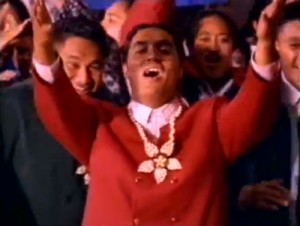 A YouTube commenter sums up the impact of this video thusly: “it was hits like this that actually triggered off and established the Pacifica brand, thus Aotearoa actually taking into consideration what the islands had to offer in terms of creative arts and music”. And there’s something to be said for a video that is full of bold, fresh young Polynesian culture.
A YouTube commenter sums up the impact of this video thusly: “it was hits like this that actually triggered off and established the Pacifica brand, thus Aotearoa actually taking into consideration what the islands had to offer in terms of creative arts and music”. And there’s something to be said for a video that is full of bold, fresh young Polynesian culture.
“Groovalation” is an upbeat track, merging traditional Polynesian music styles with contemporary hip hop, pop and R&B and multi-lingual lyrics. It’s a bit of everything and could only come from New Zealand.
Igelese Ete worked hard to get the video funded. As Dub Dot Dash notes, the initially labelless song was turned down three times for video funding before indie label Papa Pacific finally came along.
The video takes a similar form, using scenes of traditional Polynesian performers, mixed with the contemporary performers. The more traditional bits of the video are shot in sepiatone, giving it a bit of reverential distance. Whereas the big joyful crowd singalong (and shoutalong sometimes) is filmed in colour, which is just as well considering the bright palette of the lavalava, suits and and sportswear the large group is wearing.
The video gets away with things that might not work in another situation. While the group bust out a multi-lingual rap in the middle of the song, the video alternates between footage of the rapping and footage of an older man in tradition dress who appears to be chanting something unrelated to the song. While this song helped pave the way for contemporary Pacific culture in New Zealand, it is very much aware of those who came before them.
Best bit: the slightly out-of-place “Ski Colorado” sweatshirt.
Directors: Simon Baumfield, Makerita Urale
Ngā Taonga Sound & Vision
Next… time travel.
Ngaire “Can You Be Strong For Me”
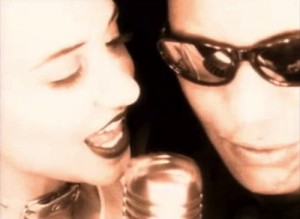 Ngaire’s fourth (and possibly last NZ On Air-funded single) is a duet. She teams up with D, aka Dave Letoa, a member of her live band. It’s an unusual pairing. Ngaire is very glamorous in the video, but we don’t see her until 30 seconds into the song. Instead it kicks off with D, who isn’t much of a pop star.
Ngaire’s fourth (and possibly last NZ On Air-funded single) is a duet. She teams up with D, aka Dave Letoa, a member of her live band. It’s an unusual pairing. Ngaire is very glamorous in the video, but we don’t see her until 30 seconds into the song. Instead it kicks off with D, who isn’t much of a pop star.
For a start, he wears sunglasses throughout the entire music video. It has a weird effect, especially when Ngaire joins him and they look into each other’s eyes. Except she’s actually looking at herself reflected in his mirrored specs.
His voice isn’t anywhere near as expressive as Ngaire’s so it all comes across as a really odd pairing. How did this asymmetrical duet come about? Why does D seem to reluctant to be part of the video?
But the video itself is generally a very stylish number. It’s shot in black and white with a slight sepiatone tint. Ngaire and D are shot in close up with bright lighting, emphasising her glamour.
Also appearing in the video are a selection music video staples, including a male dancer doing the open shit/wind machine thing, a couple dancing in silhouette and fencer. But my favourite is the line-up of models, which seems to have been inspired by the Calvin Klein CK One ads.
It feels like the video wants to be really sexy and glam but D just can’t do it. It’s just not where he’s at. And that ends up being an anchor to reality. This is not New York. This is New Zealand.
Next… the great Persevero.
Lodger “Forever”
 Lodger was a side project by Damon Newton of the Dead Flowers – especially a one-man band, from what I can tell. And the dramatic waltz “Forever” has a similar sound to the slower, more ballady numbers that the Flowers did.
Lodger was a side project by Damon Newton of the Dead Flowers – especially a one-man band, from what I can tell. And the dramatic waltz “Forever” has a similar sound to the slower, more ballady numbers that the Flowers did.
The video, directed by Jonathan King, keeps things very simple. It’s shot in black and white, with Damon sitting in a black room. He’s surrounded by a very particular selection of items: a grandfather clock, a pocket watch, two clockwork birds in a cage, suitcases, a trunk and two sheet-draped chairs. All highly symbolic.
Actually, I would like to meet someone who actually has a house decorated with every room like something out of a music video. It’s not a fridge, it’s a symbol of a failed marriage. And the kitchen bench always has milk dribbling off it.
There’s also a woman in the room. She doesn’t seem to acknowledge Damon, which probably means she’s a ghost and/or a memory. I might have been worried about ghost lady being just a music video prop, but she actually comes across as being cooler and more interesting than Mr Lodger. While he’s hunched over in his chair being mournful and miserable, she steals the show with her awesome hair and general air of confidence.
The challenge of this minimal setting is to keep things interesting. With a melancholic song and a low-key performance from the artist, it’s up to the director to add some zip – and this is largely done with editing. The verses slouch along, with the pace picking up for the chorus, shots overlapping to create a dreamlike feeling. Quite nice.
Best bit: that the woman is more interested in the wind-up birds than the man. #symbolism
Director: Jonathan King
Ngā Taonga Sound & Vision
Next… a video for a man or a woman.
Semi Lemon Kola “Otherwise”
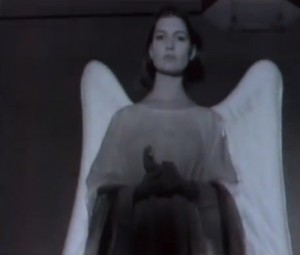 Semi Lemon Kola had perfected the contemporary grunge rock sound of the mid-’90s. “Otherwise” absolutely sounds like an artefact of this era and even though I don’t think I’ve heard the song before, it takes me back to this era.
Semi Lemon Kola had perfected the contemporary grunge rock sound of the mid-’90s. “Otherwise” absolutely sounds like an artefact of this era and even though I don’t think I’ve heard the song before, it takes me back to this era.
The video starts with an angel, a woman serenely posing with wings and looking very Catholic. There’s footage of a church, but we quickly get straight to the band. The video is shot in black and white with lots of dramatic shadows of window frames, like they’re the indoor variety angsty teen.
The action is cut very rapidly, with the only moments of reflection being given to the angel. It’s like she’s there as the calm centre of the crazy “Otherwise” universe. But despite her presence, things get even crazier as the song ramps us. Near the end, the video bursts into colour, with shots of the band performing live. It’s a manic ending, far removed from the chilled out world of the angel.
I get the feeling this song would have done quite well on Channel Z, the alterno rock radio station of the era. It’s so ’90s that I can’t quite take it on its own terms. It feels old.
Best bit: the angel’s ’90s bob.
Director: Jonathan King
Ngā Taonga Sound & Vision
Next… hair and confidence.
Joint Force “Burntime”
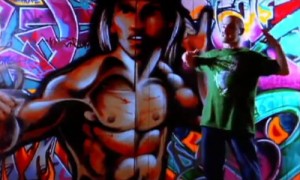 MC OJ, Rhythm Slave and DLT return with the dub-influenced “Burntime”. Rather than the ambitiously cinematic “Static” video, “Burntime” keeps it much simpler with basic hip hop culture.
MC OJ, Rhythm Slave and DLT return with the dub-influenced “Burntime”. Rather than the ambitiously cinematic “Static” video, “Burntime” keeps it much simpler with basic hip hop culture.
The video Ross Cunningham-directed video focuses on graffiti and breaking, letting Joint Force’s MCing and DJing take a back seat. And there’s graffiti art galore, with Otis and Mark rapping in front of giant murals, no green screen required.
Vinyl offcuts are laid down on the studio floor for some B-boy moves from the Megazoid crew. You know, there’s something very pleasing about seeing some classic breakdance moves.
There’s also good timelapse photography of a giant piece being painted by OJ, DLT and DT (aka Dan Tippett). A mural of scenic New Zealand is covered up with a new work proclaiming “BURN TIME”. It’s all very symbolic, with the great outdoors covered up with some fresh urban style.
The whole video serves as a valentine to New Zealand hip hop culture without forcing it like Scribe’s “Stand Up”. Here were a bunch of guys doing what they did and doing it well. And it worked – they’re still all part of New Zealand hip hop culture today.
Best bit: the headspin.
Director: Ross Cunningham
Ngā Taonga Sound & Vision
Upper Hutt Posse “As the Blind See”
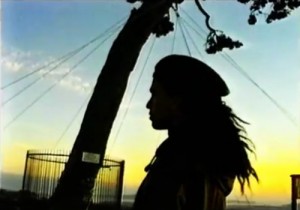 Upper Hutt Posse turn with another protest song, this time wrapped up in a cool soul groove with an equally cool video. Directed by Rongotai Lomas, the video is shot in high-contrast black and white, emphasing the Posse’s talent as musicians in a recording studio. Dean Hapeta raps as he’s seated at a grand piano, and Emma Paki turns up about halfway through the song to add her sweet, strong vocals to the chorus.
Upper Hutt Posse turn with another protest song, this time wrapped up in a cool soul groove with an equally cool video. Directed by Rongotai Lomas, the video is shot in high-contrast black and white, emphasing the Posse’s talent as musicians in a recording studio. Dean Hapeta raps as he’s seated at a grand piano, and Emma Paki turns up about halfway through the song to add her sweet, strong vocals to the chorus.
But there’s life outside the safe bubble of the studio, and indeed it wouldn’t be an Upper Hutt Posse video without examples of the things that make the Posse angry. There’s a moody stroll past Mt Eden Prison; a visit to One Tree Hill’s summit, the damaged tree supported by guy ropes; and Dean takes a tense walk past a line of police officers still wearing the old custodian helmet style of hats.
Both the song and the video have a strong message, but unlike earlier Upper Hutt Posse videos that have been packed with symbols, this video has a more minimalist style. By keeping the visuals simple, the music and its message are the stars.
Best bit: Dean’s slow turn to the camera at 3:11, which seems to include a sigh.
Director: Rongotai Lomas
Ngā Taonga Sound & Vision
Joint Force “Static (Part 1)”
 After bursting onto the scene as hip hop duo MC OJ and Rhythm Slave, Otis and Mark later teamed up with DLT, previously of Upper Hutt Posse. Together the three were Joint Force – a nice short two-syllable name.
After bursting onto the scene as hip hop duo MC OJ and Rhythm Slave, Otis and Mark later teamed up with DLT, previously of Upper Hutt Posse. Together the three were Joint Force – a nice short two-syllable name.
The “Static” video is incredibly ambitious. Rather than just showcasing the first single of this new trio, a rage against the media, the song becomes a soundtrack to a stylish action film, very strongly inspired by the hip new films of Quentin Tarantino.
There are plenty of music videos from the mid ’90s that were gripped with Tarantino fever, but the “Static” video actually manages to pull it off this particular style. I reckon it works because Joint Force were as cool as characters in a Tarantino film.
We meet Otis and Darryl in the particularly photogenic men’s toilets at Hotel DeBrett. These toilets also feature in Cicada’s 1996 “Future Folds” video and Tadpole’s “For Me”.
A mysterious Russian woman takes a phone call and some evil scientists attempt to decipher the secret codes in the group’s performance. Meanwhile, Mark emerges from the sea and then joins his bros in the loos.
As this may all suggest, there’s a lot of plot and acting in the video and sometimes the song takes second place. But that’s ok. It’s such a strong song that the snippets that bubble up from under the acting make me want to hear more. (And the full version can be heard below.)
All the mystery and intrigue in the video leads to a thrilling cliffhanger with a bomb about to explode. What happens next? Forget the video – next I’m going to try and track down the group’s “One Inch Punch” EP.
And here’s “Static (Part 2)”. It’s the full song – no high jinks – just the raw performance footage of the group that’s occasionally featured in Part 1. DIY Steadicam provided by a bungy cord.
Otis explains (via Facebook) how the second version came to be released:
We actually just shot this version so we had something to put on the monitors in the ‘CIA’ office when they were trying to decipher our codes in the other video. But it’s kinda nice and slick ‘n’ simple so we thought, Fuck it… Put ’em both out.
Director: Josh Frizzell
Ngā Taonga Sound & Vision
Maree Sheehan “You Can’t Hide Love”
 Oh, there are some kitschy delights in this video. Maree gets four different looks in this video, not unlike a pop version of Teremoana’s very serious “Four Women” video. There’s a ’60s chick with a heavy fringe and a mini dress, a long-haired hippy chick from the ’70s, a staunch ’90s chick with hair in Bjork minibuns, and a fabulous poolside diva.
Oh, there are some kitschy delights in this video. Maree gets four different looks in this video, not unlike a pop version of Teremoana’s very serious “Four Women” video. There’s a ’60s chick with a heavy fringe and a mini dress, a long-haired hippy chick from the ’70s, a staunch ’90s chick with hair in Bjork minibuns, and a fabulous poolside diva.
The song has echoes of Cheryl Lynn’s disco classic “Got to be Real”, so the video wisely plays to that fun dance side. But I’m not sure if it’s entirely sucessful. Maree has a soft, sultry voice that doesn’t quite work with the bold diva ideals of the song. The video just underscores this, making it seem like a slowed-down version of a disco classic.
The poolside scenes are the best, with Maree lounges fabulously while various young men hang out in speedos. These scenes work well because the lazier pace matches the song better than the faster studio bits, and it looks like a fun place to be.
Best bit: the pool cleaner, wandering back and forth, doing his job.
Director: Mark Tierney
Ngā Taonga Sound & Vision
